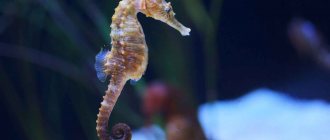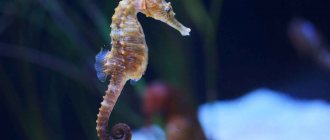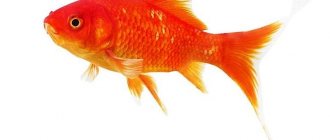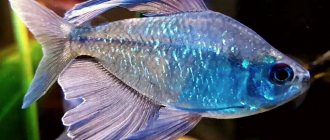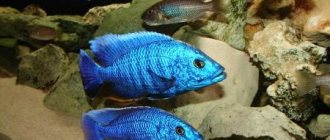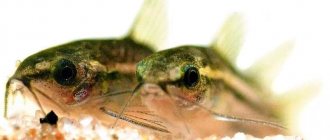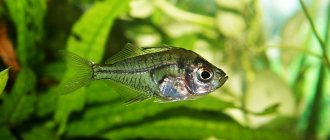From the outside it may seem that caring for a home aquarium and even breeding your favorite fish is a simple matter and does not require significant effort. However, to make a small home pond look well-groomed and its inhabitants feel good, effort will be required.
If you carefully monitor the water parameters and temperature in the aquarium, choose good food and do not forget to change the water, you can speed up the spawning of fish. And not only unpretentious guppies, with good care even such capricious fish as angelfish will lay eggs.
Angel fish
The hobby of many aquarists began with their acquaintance with this leisurely fish with long lacy fins. In nature, angelfish (Pterophyllum scalare) live in the slow waters of the tributaries of the Amazon, among thickets of plants, in the shade of which they hide from danger and gather to spawn. The body of the fish, very flattened on the sides, is ideally designed to maneuver between the roots and leaves of plants.
The name of the angelfish (Zeus scalaris) was given to this species of then still wild fish in 1823. However, in Germany, breeders still call the fish Segelflosser, which translates as “sail”. And in the United States they are known as “angelfishes” (Angelfishes or simply Angel).
Over several decades of aquarium breeding, these fish have been able to adapt to almost any conditions. They can feel normal in both soft and hard water, and small temperature fluctuations are not scary for fish. However, if you want the angelfish to lay eggs, they will need to create conditions suitable for this.
Life of schooling fish
Some types of aquarium fish, for example, almost all bottom-dwelling catfish, feel great alone. With angelfish, everything is not so simple; in nature, they are schooling fish, living in groups of 10–15 individuals. And even long-term domestication could not change this habit: representatives of this species feel good only in a group.
Experienced aquarists advise choosing a dozen small angelfish with wide and long fins. Then, as they grow older, the fish themselves will split into pairs. Usually in an aquarium there is one dominant pair of angelfish, the largest and with a good appetite. The rest of the fish will stay away.
Most likely, it is this dominant pair that will lay angelfish eggs in the aquarium. Although, if the aquarium is large enough and has a lot of plants for cover, other fish will also have a chance to reproduce.
Pair for angelfish
Experienced aquarists do not recommend separating an already established pair of fish, even if the breeder does not entirely like this “union”. For fish this is extreme stress, possible refusal of food, and even the death of the pet.
If you really want to breed juveniles with certain characteristics, you can try placing a male and a female of the appropriate gender and size in a separate aquarium. It is quite difficult to determine the sex of young fish; there are several common signs:
- Males have a more elongated, long dorsal fin.
- The number of transverse contrasting stripes on the dorsal fin in the female is no more than 6, and in the male more than 7.
- Males are usually larger and have a round body. Females have a smaller body and are not so rounded, rather angular.
- The male has a more convex round forehead, which will become golden in color with age. In females, the forehead is sloping and visually merges into the dorsal fin.
In addition, you can determine the sex of young fish by observing their behavior; males are always aggressive and assertive. Females stay in a flock and spend more time searching for food.
Once the two of you are in the same aquarium, the selected fish will become friends, and soon you will be able to observe the preparations for the start of spawning.
Problems
- Breed aquarium fish responsibly. Create conditions for future fish in advance. Calculate how much aquarium volume you will need. Often, due to incorrect calculations or too many offspring, fish suffer from overpopulation. When there is not enough space, the fish become aggressive towards each other and experience stress. In an overcrowded tank, the fish grow smaller in size, which leads to subsequent health problems.
- Another problem is that the fry do not survive to the teenage stage. The death of fry is caused by improper selection of food and poor water quality. Remember that there should be no large particles of food in the container with the fry.
- Avoid inbreeding. Population degeneration occurs due to heterosexual offspring not separated in time. The fish look less bright and may have problems with further self-reproduction. The same applies to closely related species (swordtails, mollies, platies).
- If the necessary conditions are created, and the fish do not reproduce or lay infertile eggs, choose another male as the breeder. Most likely, his gonopodium is damaged or he is already old. The lack of offspring is also associated with unsuitable water parameters. If a white coating appears on the eggs, check whether the temperature is suitable for the fish and whether the water is too hard or soft.
Conditions for reproduction
In order for the selected pair to successfully lay eggs, they need to create optimal conditions. Despite the assurances of manufacturers, it is better to feed the fish with live food (bloodworms, cyclops, daphnia) before spawning, then the pets will have a brighter color and a desire to reproduce.
The spawning aquarium must be planted with living plants with large, dense leaves. Most likely, the angelfish will lay their eggs in the aquarium on one of these sheets. It’s good if duckweed or other small plants float on the surface of the water, they will provide comfortable twilight and additional vitamins for green-eating producers.
Without relying on plant leaves, you can lower a piece of dark plastic or a smooth ceramic pot into the aquarium. Of course, they should be thoroughly washed first. Perhaps a pair will choose these surfaces for spawning and eggs will soon appear on them. Although parents' preferences are unpredictable, and you can see angelfish caviar on the filter, and not on carefully prepared items.
Peculiarities of reproduction of popular fish
Fish reproduction is accompanied by interesting features:
- Some fish care for their offspring during the egg stage. Then their parental instincts fade away.
- Male cichlids, on the contrary, are overly worried about the offspring and show aggression towards females if they don’t like something in the treatment of the offspring.
- A sharp change in conditions in viviparous fish leads to a change in sex from female to male.
- Discus fish, angelfish and fairy cichlids take a long time to choose a partner for mating and form a pair for life.
Temperature and water changes
To stimulate, the water temperature should be increased to 28° C; in fish, at the genetic level, this will be an indicator of the beginning of the warm season and the time of spawning. In nature, it is with the onset of warmth that young individuals begin to break into pairs and lay eggs.
You will also need to regularly do water changes 3-4 times a week, replacing approximately 10% of the total volume. It is important that distilled or pre-boiled water must be added to reduce its hardness. And the temperature should be close to the one in which the pets are used to living.
Determining readiness
The beginning of the mating season is determined by the intensity of the colors and habits of the fish. The color of males becomes brighter and more saturated, pigment spots appear. Goldfish develop tubercles on their gills.
The behavior of males is characterized by activity and sometimes aggressiveness towards rivals. Fights often occur between males.
Mating rituals and courtship of the female begin. Some males independently prepare a spawning area, where they then invite a female, swollen with ripened eggs, to lay eggs.
Angelfish caviar in an aquarium
Fish of this species should not be removed from the general aquarium before spawning. Of course, unless they have large neighbors with a good appetite.
Signs that the pair is preparing to spawn will become noticeable within a few days. They will begin to jealously guard part of the aquarium, driving away all neighbors from there. Usually the male does this, and the female carefully cleans the selected surface.
An inexperienced aquarist can easily miss these signs and only accidentally notice that angelfish have laid eggs in a community aquarium. Having discovered this, you need to observe how the parents behave and how serious the gastronomic interest in caviar is shown by the neighbors.
Differences between male and female
The main condition for the successful reproduction of fish in an aquarium is the presence of specimens of different sexes. Most of them have clearly distinguishable sexual characteristics, so it is quite easy to separate them outwardly.
Most of the fish have clearly distinguishable sexual characteristics
Males, as a rule, are more beautiful, bright, colorful, and have lush and large fins. Female specimens are usually more massive, have an inconspicuous appearance and a more rounded anal fin. Sex differences appear in all fish species as they approach their first spawning. It is extremely difficult to distinguish fry from the outside. Therefore, in order not to make a mistake, they immediately purchase a flock of 5-6 specimens. Among them there will probably be individuals of both sexes.
As for internal differences, the main differentiation is the development of germ cells. In the female, eggs (eggs) are formed in the ovaries, which have a thin membrane for the unhindered penetration of the male reproductive cell. When mature, the eggs are released through a small opening located next to the anus.
In males, milt is produced in the testes, consisting of millions of sperm located in paired sacs. The seminal fluid comes out through the vas deferens. In nature, the maturation of cells of both sexes occurs simultaneously.
Spawning
The reason is still not clear, but angelfish prefer to spawn in the evening, closer to night. The female lays a series of eggs on a selected and thoroughly cleaned leaf or object. It swims away a little, giving way to the male, who fertilizes the eggs. Then they change places again, and so on several times. These coordinated movements resemble an underwater dance.
Spawning can last from forty minutes to one and a half hours, during which time the female will lay more than 500 eggs. In an adult large individual, the number of eggs can exceed a thousand. And the male will be nearby all the time.
Angelfish eggs look like small transparent grains that thickly cover a leaf or glass of an aquarium. In fact, the yolk sac of this tiny ball contains enough nutrients for the birth of a full-fledged small fish.
How do aquarium fish reproduce?
There are several natural ways to reproduce fish:
Sexual method
The most popular method of fertilization. It involves the insemination of eggs that mature in the body of females with the seminal fluid of males. It can be both internal (when fertilization occurs inside the female) and external (the eggs are inseminated outside the mother’s body). At the same time, the process of the birth of babies depends on the method of bearing the eggs.
The sexual method of fertilization can be both internal and external
There are spawning, viviparous and ovoviviparous females. Approximately equal numbers of each sex hatch from the eggs.
Parthenogenesis
This method involves the development of eggs without fertilization by the male. This is how commercial fish, cyprinids, usually reproduce. It is extremely rare in aquarium conditions. Such offspring die at the egg stage; even with successful birth, the fry are weak and non-viable.
Gynogenesis
Gynogenesis involves the activation of spawning by seminal fluid of males of other fish species similar to the female. In this case, direct fertilization does not occur. The seed penetrates inside the female cell, but due to different species structures, the cell nuclei do not connect. With this method, only females are born.
Hermaphroditism
It is expressed in the fact that the same individual can alternately have either male or female genital organs. These processes occur at completely different times, so the animal does not self-fertilize.
Only in exceptional cases can stored eggs be fertilized by the same individual. For example, swordtails have this ability. Sex changes occur depending on living conditions and the sex ratio in the population.
The swordtail can alternately have either male or female genitalia
Angelfish have laid eggs: what to do?
The first two days after spawning, parents protect the future offspring, driving away uninvited guests from them. They improve water circulation by fanning the eggs with their dorsal and pectoral fins, and carefully clean the rows of balls, pecking off the whitened dead samples. By this, the fish prevent damage to neighboring eggs.
After a couple of days, the larvae begin to hatch. It looks like this: thin movable tails appear from the angelfish eggs, resembling transparent threads.
During this period, a pair of parents carefully transfers the moving eggs with their mouths to a neighboring leaf. Thanks to their innate instinct, they protect their offspring from death, because proximity to deteriorating empty shells is very harmful.
The development of the larvae continues for another 7–12 days, during which time the supply of nutrients in the yolk sac runs out and, finally, fry from the angelfish eggs appear.
A pair of parents protect and care for their offspring until the small fish begin to feed on their own.
- Fish scattering eggs
- Fish hanging eggs
- Fish burying eggs
- Fishes that lay eggs in the mantle cavity of mollusks
- Fish guarding eggs
- Fish moisturizing caviar
- Fish hiding eggs
- Fishes building nests
- Fish that carry eggs with them
CHAPTER 21 FISH REPRODUCTION
Fish scattering eggs
This group includes the largest number of species. It includes the main part of tetras and barbs, some catfish and carp. Spawning ends with a more or less random scattering of eggs in all directions. What all fish in this group have in common is the lack of care for their offspring.
To prevent the eggs from being eaten, you need to make sure that the fish cannot find them. During spawning, the number of eggs eaten is small, and a flash of interest in them serves as an indicator of the completion of this process. A measure to protect the eggs to some extent is to reduce the illumination.
Fish that spawn among plants can be kept from eating eggs too greedily by forming very dense thickets in the aquarium. A layer of pebbles or glass beads, among which are eggs, is the easiest way to protect them. After spawning is completed, the parents must be removed. After the larvae hatch, they are given ciliates. As the larvae grow, they can consume artemia and small daphnia.
Fish hanging eggs
The eggs of these fish hang on plants, usually near the tops. The fish stick their eggs together using a thin sticky thread and usually do not eat their eggs. Most representatives of this group can be left in spawning grounds until the larvae hatch, but as soon as the latter begin to move, the parents should be removed.
The female usually does not lay all the eggs at once, but in portions - 10 - 12 eggs on one day, the same number on the next, and after another day the supply of eggs is depleted and the female “takes a vacation.” Sometimes a healthy fish spawns daily until the number of eggs reaches 150 - 200. The development of larvae is also gradual: some go through the incubation period, others begin to hatch, others are already swimming freely, and, in the end, a real mishmash of all kinds of babies is created in the aquarium sizes. They should be sorted into age groups and isolated from each other so that the older ones do not eat their younger brothers and sisters. The larvae should not be fed with ciliates for too long; with their large mouths they are able to swallow artemia nauplii and small daphnia. The fry grow quickly. This group includes Rivulus, Fundulus, Afiosemion, and Spanish Valencia.
Fish burying eggs
Fish of this subgroup are distinguished by the most unusual spawning habits. Nature has endowed these beauties with instincts that ensure survival in conditions where water appears only during the rainy seasons.
These are “one-year-olds”. They live in those areas of South America and Africa where the contrast between the rainy and dry seasons is especially striking: in the wet months, rivers and ponds are full, but in hot and dry months, all that remains is a layer of dried, cracked silt, covered with the decaying corpses of small fish. When the rains begin again, tiny fry appear as if life is boiling again in the air and water. The fry grow quickly and soon reach maturity. However, around the same time, the rainy season ends: the water gradually decreases and the situation becomes critical. Soon the fish die from the drying out of the reservoirs. However, by this time they had already finished spawning and left behind thousands of eggs fertilized and buried in the mud. During drought, the eggs are dormant. When the drought is replaced by rains again, the shells of the eggs burst and the larvae are released from them.
Fishes of this species include Arnold's Afiosemion, Vellot's Cynobelia, Star Cynobelia, Günther's Notobranchius, Red Notobranchius, Rakhov's Notobranchius, Rakhovia brevis, and Rachovia brevis.
Fishes that lay eggs in the mantle cavity of mollusks
This species includes common bitterweed. During the spawning period, bitterlings transform, although the rest of the time they are ordinary silvery fish with a vaguely defined horizontal stripe in the back of the body. During spawning, this stripe becomes bright blue, the belly and anal fin of the male turn very red, the outer half of the caudal and dorsal fin become yellow, and green spots appear on the dorsal fin. A horizontal stripe also appears on the female’s body, which takes on a soft pink color.
Under natural conditions, the spawning period for bitterlings lasts from April to June. When the female is filled with eggs and the male is painted in his breeding plumage, they should be transplanted into a well-greened spawning tank with a capacity of about 40 liters and with settled water at a temperature of 21 ° C and with several live bivalve freshwater mollusks. When a female is ready to lay eggs, she has a thin pink ovipositor about 5 cm long, hanging from her abdomen like a worm. Having chosen one of the mollusks, she very carefully inserts the ovipositor between the valves of its shell and, having completed this tricky operation, releases up to 40 eggs into the mantle cavity. The male is nearby at this time and, when the female removes the ovipositor from the suction siphon, irrigates this siphon with milk. With water constantly pumped through the gills of the mollusk, milk is drawn into the mantle cavity, where fertilization of the eggs occurs. For 4 - 5 weeks, the eggs are in a well-aerated environment under the protection of the host mollusk, without causing him any harm or disturbance. At the end of the incubation period, the larvae come out and feed on ciliates for several days, and then switch to brine shrimp and other, larger food.
Fish guarding eggs
During the spawning process in fish of this group, eggs, and in most cases larvae, are under the constant supervision of their parents. These responsibilities are performed by both parents or one of them.
When choosing a partner, these fish are quite picky, and the recommendation to have at least half a dozen fish at once for breeding in this case turns out to be very reasonable. When the fish reach maturity and are ready to spawn, they choose their own partners according to their taste. If you have only one pair, it is best to disperse the partners until the female’s abdomen is rounded, and the brightness of the color and the aggressiveness of the male indicate that he is also ready to reproduce. Choose a time for the couple's reunion when you can observe them. If no complications arise between the fish and the male does not begin to attack the female too fiercely, tearing off her fins, then the selection can be considered successful. Sometimes the female is so busy caring for her offspring that she completely forgets about food and ends up snacking on the eggs. When caring for the eggs, the parents constantly ventilate them, making soft oscillatory movements with their pectoral fins. The parents keep the eggs clean by occasionally taking them into their mouths.
Fish of this species include lyretail cichlid, dwarf Congo cichlid, angelfish, and discus.
Fish moisturizing caviar
This is Arnold's kopeck. It lives in the waters of the Amazon in Brazil and Venezuela. Copeina spawning occurs in a completely unusual way. The fish look for a leaf or some kind of stone hanging over the surface of the water that they can jump to, and the female lays eggs on such a substrate. Why don't the eggs dry out? Parents constantly moisten them by swimming from below and spraying the clutch with water. The hatching larvae fall into the water and swim away.
Fish hiding eggs
This subgroup includes dwarf cichlids. Preferring to hide their eggs, they do not have the habit of digging up plants, which is inherent in most of their large relatives. For spawning, they need a temperature of 25.5 - 26.5 ° C, but in the pre-spawning period it is best to reduce it slightly, for example to 24 ° C.
Green the spawning area well - this gives the fish a feeling of security, put a few stones and a small flower pot, choosing a darker corner for it. Turn the pot's neck away from the light, and perhaps the cichlids will choose this particular place for spawning. Under the pot, the male busily digs a hole in advance, spitting out all the small pieces of gravel until he manages to restore complete order. Then he chooses a female, and woe to her if she is not yet ready to spawn.
Check the condition of the female, if necessary, transfer her to another aquarium and feed her properly until her abdomen is rounded, otherwise the poor creature will get a hard time from her partner.
The mature female soon allows herself to be driven to the spawning ground and lays a bunch of eggs, which the male immediately fertilizes. But as soon as the spawning is over, amazing changes happen to the female: from a modest, timid creature, she turns into a real tigress, chasing and biting her almost twice as large spouse until he takes flight.
Left to her own devices, the female usually takes touching care of the eggs and larvae, but sometimes, especially in a turbulent environment, she suddenly comes to the idea that this is a tasty dish and begins to eat them. Consequently, in this case, it is possible to obtain a normal offspring only by artificially rearing the young.
Fishes building nests
Ceylon macropod, graceful and ribbon cockerel, Siamese cockerel, armored callicht catfish, giant gourami, lalius, Chinese macropod, true and pearl gourami, striped and spotted gourami - this is a group of fish that build something like a nest for eggs and young.
Foam nest builders construct a kind of foam cap from mucus-covered air bubbles on the surface of the water. The appearance of such a floating nest on the water serves as a signal that the male is ready to spawn. The mature female fills the nest with hundreds of eggs, and the male carefully guards it until the larvae begin to swim freely.
The second type of nest is built by the well-known sticklebacks. These fish collect pieces of plants, twigs and other debris, roll them into a nest and attach it to underwater plants. The entire structure is “cemented” with mucus. A through passage is left in the nest, and when a fish sits in it, its head sticks out from one exit, and its tail from the other. Parental duties are also performed by the male - a tiny, eternally irritated creature, fearlessly attacking anyone who dares to threaten his offspring.
Fish that carry eggs with them
Species of this subgroup are characterized by one common property: the laid eggs hang from the female’s abdomen for varying periods of time and fall off when she accidentally touches a plant or something else with her caudal fin. The parents no longer care about the hatched larvae. This species includes the Cuban killi, Javan orysia, and Japanese medaka.
Table of contents
In fact
Although parental care is extremely important for the development of small fish, adult fish do not provide as much care. Even if you place the selected pair in a separate aquarium, there will be no guarantee that the parents will care for the eggs. This is especially true for young individuals.
And angelfish (fry) simply have no chance of hatching from eggs in a community aquarium without outside help. At best, the couple will try to protect the eggs for the first two days. But the stress from spawning and the interference of voracious neighbors leads to the fact that some of the offspring will be eaten and the rest will disappear.
It happens that when darkness falls, the parents themselves get lost and eat the recently laid eggs.
There are several options for what to do with angelfish eggs in a community aquarium. You can leave everything as is, then the pets will receive an additional portion of food, and the pair will be ready for the next spawning in about a month.
And those who set out to raise a school of small fish have two options: place the parents together with the eggs, or equip a small aquarium and turn into a nanny for a while.
Pairing: natural and artificial
The key to the success of the venture is the health of the producers and how to correctly distinguish a female from a male angelfish. Selecting the father and mother of a fish replenishment carries with it some difficulties. Before sexual maturity, it is almost impossible to determine the difference between an individual and one sex, due to the weak expression of dimorphism (not everyone can distinguish the sex). A pair is created once for the entire duration of its existence.
Natural way
Regular observation of the habits of adult individuals will give certain results in selection. If there are several fish in the aquarium, it is possible to notice isolated pairs sticking close to each other. The male strives to win the full attention of the female and court her. This is where gender differences lie.
Artificial pairing
With the development of selection characteristics (breeding new colors, types of fins, consolidation of successful variations obtained), a female angelfish with the required pronounced characteristics is selected and moved to a separate container. Next, the choice falls on the male who meets the necessary criteria. The selected unit is transplanted to the previously isolated one. It is important to have time to carry out this operation before the natural emergence of attachment. After some time, the migrants multiply.
Caviar with parents
You can place the pair along with the eggs in a separate aquarium, then the fry will have a greater chance of hatching. Parental care is very important for the health of small fish, but difficulties may arise during transplantation:
- Additional aquarium. Few aquarists, especially beginners, can boast of having another tank with a volume of 50–80 liters. And in a smaller volume of water, two large fish will not feel comfortable and care for their offspring.
- The water parameters in a new aquarium should correspond as closely as possible to the water in general. It is optimal to take 30–40 percent of the water from the general aquarium, and add the rest of the volume with distilled or boiled water.
- Adult fish may react poorly to being moved to a new location and may stop caring for the eggs.
It is optimal to prepare for spawning in advance: place a couple of breeders in a separate aquarium in advance, feed them correctly and monitor water parameters.
However, after the fry hatch from the angelfish eggs, the adults need to be placed back in the community aquarium. Parental feelings for small, flickering fish will weaken, and adults can eat their offspring.
Onset of puberty
Direct is characterized by a similar structure of fry and adult fish. Indirect development occurs with transformations: the born individual does not resemble its parents. Those that lay eggs are characterized by an indirect type of development.
To have a similar structure to adult individuals, the offspring go through several stages:
- An embryo is formed inside the egg.
- After passing through the embryonic stage of development, the future fry enters the larval stage. It begins with a rupture of the egg membrane. The larva has large eyes and an elongated body without fins. In the first few days the larva is motionless.
- The whitebait visually resembles a smaller copy of an adult fish. Scales and fins appear.
- Gradually the fry grows to adulthood.
Viviparous species produce independent and structurally similar offspring - fry. This is a direct development.
Fish with a short life cycle become ready to reproduce earlier. Already at the age of 2 months, the fish is ready to reproduce. In small cichlids - at 3 months. Large fish with a long lifespan develop by 4-5 years. There are species that mature in 15-30 years. Males reach puberty earlier than females.
Separate aquarium for fry
A good option would be to prepare a small aquarium for the fry, into which you need to transfer the eggs. It should be transported carefully, together with the object to which the eggs are attached. If the grains are on the leaf of the plant, you will have to sacrifice the leaf and carefully separate it from the stem.
In order for the fry to appear successfully, the aquarium for them must meet certain requirements:
- It can be small, 10 or 20 liters, but it must be cleanly washed and disinfected using Aquacons antiseptic conditioner. It’s a good idea to add a few drops of this drug to the water for fry.
- Take half the water from the general aquarium, add the rest with boiled or distilled water.
- There should be no soil or decorations in the aquarium, but it is necessary that the lighting lamp is constantly on.
- Be sure to place a heater and an air diffuser there. Wait about an hour and transfer the item with the caviar. It must be positioned so that the eggs are washed by the flow of water from the aerator, but the air bubbles do not touch them. This will create the same effect as fanning the eggs with the parents' fins.
- Place small plants such as duckweed on the surface; they will grow quickly in the light and create shelter, and then food, for small fish. In addition, having live plants will prevent nitrate levels from rising when the fry begin to actively grow.
Several times a day, you need to remove frozen eggs with tweezers, trying not to damage the neighboring grains. If all goes well, after two weeks the first small fish will begin to appear.
Creating comfortable conditions for successful fish breeding
Before breeding goldfish, the spawning tank must be properly prepared and all favorable conditions must be created for subsequent spawning. First, a small number of plants with small leaves should be placed in the container that is intended to be used for propagation. For placement in the spawning tank, you can use plants such as hornwort, or for example, elodea. It is best to press all plants to the bottom of the container with a small weight.
Hornwort is a win-win option for landscaping spawning grounds.
In a spawning tank used for breeding and raising goldfish fry, instead of plants, you can alternatively place small bundles of finely plucked loofah. It should be noted that willow sponges cannot be used. Bunches of loofah are placed in the container in the same way as plants. Egg-laying fish, which include goldfish, unlike viviparous fish (for example, platies), do not give birth to live fry. They lay eggs, which adhere to plants or the surface of tufts of loofah. When a pregnant goldfish has spawned all its eggs, they can be removed from the spawning tank.
Some breeders use synthetic sponge fibers for spawning.
In addition, when breeding goldfish in a spawning area, you need to create comfortable conditions for spawning. To do this, you need to carefully monitor:
- water temperature;
- water filtration system and its oxygen saturation level;
- aquarium lighting.
The optimal water temperature inside the spawning tank in which it is planned to breed fish should not exceed + 28 degrees Celsius . To select the optimal water temperature for comfortable life and reproduction of goldfish, it is necessary, first of all, to pay special attention to the length of their body.
For example, in the case when the body of the fish has a long shape, then the optimal water temperature for it is no less than +15 and no more than +25 degrees Celsius. However, if the body of the fish is short, then in this case, the water temperature for its normal life and reproduction should be about 22-28 degrees Celsius.
When breeding goldfish yourself, it is recommended to pay attention to the seasonality of changes in water temperature. Simply put, in summer, the water in the spawning area should be slightly warmer than the recommended minimum value, and in winter, on the contrary, lower. Also, the water in the container in which the fish are kept must be constantly saturated with oxygen. A lack of oxygen in the water can cause oxygen starvation in fish, which can cause them to die.
Caring for fry
Raising young animals is much more difficult than caring for adults. For the first food, small ciliates or daphnia are suitable. Around the fifth day, you can give small Artemia crustaceans; you can hatch them yourself or buy them at a pet store. You should not feed your fish egg yolk, it quickly deteriorates and becomes covered with fungus, which affects the water parameters.
The fry need to be given food five times a day, at regular intervals. It is very important to carefully remove food debris from the bottom using a small siphon.
On the fifth day, you can install a small filter, this will help regulate the purity of the water. Just to prevent the fry from being sucked into it, first wrap the filter with a thin cloth or nylon stocking.
After about a month, the fish will acquire the shape characteristic of angelfish and will gradually begin to eat crushed food for adults.
After a few more weeks, you can place the grown young fish in a community aquarium or start looking for a new home for the fish. In many pet stores you can exchange healthy young fish for food or necessary equipment.
